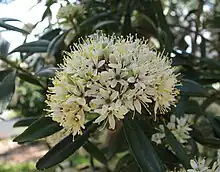| Leionema coxii | |
|---|---|
 | |
| Scientific classification | |
| Kingdom: | Plantae |
| Clade: | Tracheophytes |
| Clade: | Angiosperms |
| Clade: | Eudicots |
| Clade: | Rosids |
| Order: | Sapindales |
| Family: | Rutaceae |
| Genus: | Leionema |
| Species: | L. coxii |
| Binomial name | |
| Leionema coxii | |
Leionema coxii is a shrub species that is endemic to southern New South Wales, Australia. It has an upright habit, dark green, narrow leaves and clusters of white flowers in spring.
Description
Leionema coxii is a pyramid-shaped shrub, 1–3 m (3 ft 3 in – 9 ft 10 in) high, 1 m (3 ft 3 in) wide, occasionally a small tree to 7–8 m (23–26 ft) high with stems that grow at an angle, smooth and glandular. The leaves are lance to narrowly-elliptic shaped, 3–7 cm (1.2–2.8 in) long, 10–15 mm (0.39–0.59 in) wide, upper surface shiny, smooth, margins barely toothed, prominent midrib on lower surface and ending in a sharp point. The inflorescence is a corymb consisting of 10-30 flowers at the end of flattened more or less smooth branches. The yellowish-creamy calyx lobes are wide-triangular, smooth, petals about 5 mm (0.20 in) long and dotted with glands. The upright fruit about 5 mm (0.20 in) long with an angled beak.[2][3]
Taxonomy and naming
The species was first formally described in 1884 by Ferdinand von Mueller who gave it the name Eriostemon coxii and the description was published in The Australasian Chemist and Druggist.[4] In 1998 Paul G. Wilson changed the name to Leionema coxii and the description was published in the journal Nuytsia.[5][6] The specific epithet (coxii) honours James Charles Cox a medical practitioner of Sydney for promoting "scientific objects in the neighbouring elder colony".[4]
Distribution and habitat
This species grows in forests, brushland, near water courses and ridges from Morton National Park to the Tuross River area, mostly in the Budawang Range in southern New South Wales.[2]
References
- ↑ "Leionema coxii". Australian Plant Census. Retrieved 22 April 2020.
- 1 2 "Leionema coxii". PlantNET-NSW Flora Online. Royal Botanic Gardens Sydney. Retrieved 20 April 2020.
- ↑ Wriggley, John W.; Fagg, Murray (2001). Australian Native Plants. Louise Egerton-Read New Holland. ISBN 1876334304.
- 1 2 "Eriostmeon coxii". Australian Plant Name Index. Retrieved 22 April 2020.
- ↑ Wilson, Paul G. (1998). "New species and nomenclatural changes in Phebalium and related genera (Rutaceae)". 12 (2): 272. Retrieved 22 April 2020.
{{cite journal}}: Cite journal requires|journal=(help) - ↑ "Leionema coxii". Australian Plant Name Index. Retrieved 22 April 2020.